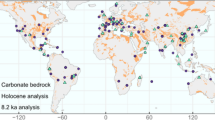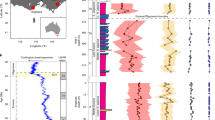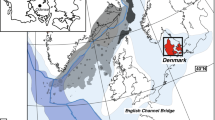Abstract
A profound global climate shift took place at the Eocene–Oligocene transition (∼33.5 million years ago) when Cretaceous/early Palaeogene greenhouse conditions gave way to icehouse conditions1,2,3. During this interval, changes in the Earth’s orbit and a long-term drop in atmospheric carbon dioxide concentrations4,5,6 resulted in both the growth of Antarctic ice sheets to approximately their modern size2,3 and the appearance of Northern Hemisphere glacial ice7,8. However, palaeoclimatic studies of this interval are contradictory: although some analyses indicate no major climatic changes9,10, others imply cooler temperatures11, increased seasonality12,13 and/or aridity12,13,14,15. Climatic conditions in high northern latitudes over this interval are particularly poorly known. Here we present northern high-latitude terrestrial climate estimates for the Eocene to Oligocene interval, based on bioclimatic analysis of terrestrially derived spore and pollen assemblages preserved in marine sediments from the Norwegian–Greenland Sea. Our data indicate a cooling of ∼5 °C in cold-month (winter) mean temperatures to 0–2 °C, and a concomitant increased seasonality before the Oi-1 glaciation event. These data indicate that a cooling component is indeed incorporated in the δ18O isotope shift across the Eocene–Oligocene transition. However, the relatively warm summer temperatures at that time mean that continental ice on East Greenland was probably restricted to alpine outlet glaciers.
This is a preview of subscription content, access via your institution
Access options
Subscribe to this journal
Receive 51 print issues and online access
$199.00 per year
only $3.90 per issue
Buy this article
- Purchase on Springer Link
- Instant access to full article PDF
Prices may be subject to local taxes which are calculated during checkout




Similar content being viewed by others
References
Zachos, J. C., Pagani, M., Sloan, L., Thomas, E. & Billups, K. Trends, rhythms, and aberrations in global climate 65 Ma to present. Science 292, 686–693 (2001)
Coxall, H. K., Wilson, P. A., Pälike, H., Lear, C. H. & Backman, J. Rapid stepwise onset of Antarctic glaciation and deeper calcite compensation in the Pacific Ocean. Nature 433, 53–57 (2005)
Lear, C. et al. Cooling and ice growth across the Eocene-Oligocene transition. Geology 36 (3) 251–354 210.1130/G1124 (2008)
Pagani, M. et al. Marked decline in atmospheric carbon dioxide concentrations during the Paleogene. Science 309, 600–603 (2005)
Pearson, P. N. & Palmer, M. R. Atmospheric carbon dioxide over the past 60 million years. Nature 406, 695–699 (2000)
DeConto, R. M. & Pollard, D. Rapid Cenozoic glaciation of Antarctica induced by declining atmospheric CO2 . Nature 421, 245–249 (2003)
Eldrett, J., Harding, I. C., Wilson, P., Butler, E. & Roberts, A. Continental ice in Greenland during the Eocene and Oligocene. Nature 446, 176–179 (2007)
Moran, K. et al. The Cenozoic palaeoenvironment of the Arctic Ocean. Nature 441, 601–605 (2006)
Kohn, M. J. et al. Climate stability across the Eocene-Oligocene transition, southern Argentina. Geology 32, 621–624 (2004)
Grimes, S. T., Hooker, J. J., Collinson, M. E. & Mattey, D. P. Summer temperatures of late Eocene to early Oligocene freshwaters. Geology 33, 189–192 (2005)
Zanazzi, A., Kohn, M. J., MacFadden, B. J. & Terry, D. O. Large temperature drop across the Eocene–Oligocene transition in central North America. Nature 445, 639–642 (2007)
Ivany, L. C., Patterson, W. P. & Lohmann, K. C. Cooler winters as a possible cause of mass extinctions at the Eocene/Oligocene boundary. Nature 407, 887–890 (2000)
Terry, D. O. Paleopedology of the Chadron Formation of northwestern Nebraska; implications for paleoclimatic change in the North American Midcontinent across the Eocene-Oligocene boundary. Palaeogeogr. Palaeoclimatol. Palaeoecol. 168, 1–38 (2001)
Sheldon, N. D., Retallack, G. J. & Tanaka, S. Geochemical climofunctions from North American soils and application to paleosols across the Eocene-Oligocene boundary in Oregon. J. Geol. 110, 687–696 (2002)
Dupont-Nivet, G. et al. Tibetan Plateau aridification linked to global cooling at the Eocene–Oligocene transition. Nature 445, 635–638 (2007)
Lear, C. H., Rosenthal, Y., Coxall, H. K. & Wilson, P. A. Late Eocene to early Miocene ice-sheet dynamics and the global carbon cycle. Paleoceanography 19 PA4015 10.1029/2004PA001039 (2004)
Lear, C. H., Elderfield, H. & Wilson, P. A. Cenozoic deep-sea temperatures and global ice volumes from Mg/Ca in benthic foraminiferal calcite. Science 287, 269–272 (2000)
St John, K. Cenozoic ice-rafting history of the Central Arctic Ocean: terrigenous sands on the Lomonosov ridge. Paleoceanography 23, PA1S05 (2008)
DeConto, R. et al. Thresholds for Cenozoic bipolar glaciation. Nature 455, 652–656 (2008)
Kobashi, T., Grossman, E. L., Yancey, T. E. & Dockery, D. T. Reevaluation of conflicting Eocene tropical temperature estimates; molluskan oxygen isotope evidence for warm low latitudes. Geology 29, 983–986 (2001)
Retallack, G. J. et al. Eocene-Oligocene extinction and paleoclimatic change near Eugene, Oregon. Geol. Soc. Am. Bull. 116, 817–839 (2004)
Thorn, V. C. & DeConto, R. M. Antarctic climate at the Eocene/Oligocene boundary; climate model sensitivity to high latitude vegetation type and comparisons with the palaeobotanical record. Palaeogeogr. Palaeoclimatol. Palaeoecol. 231, 134–157 (2006)
Eldrett, J. S., Harding, I. C., Firth, J. V. & Roberts, A. P. Magnetostratigraphic calibration of Eocene-Oligocene dinoflagellate cyst biostratigraphy from the Norwegian-Greenland Sea. Mar. Geol. 204, 91–127 (2004)
Greenwood, D. R., Archibald, S. B., Mathewes, R. W. & Moss, P. T. Fossil biotas from the Okanagan Highlands, southern British Columbia and northeastern Washington State: climates and ecosystems across an Eocene landscape. Can. J. Earth Sci. 42, 167–185 (2005)
Greenwood, D. R. & Wing, S. L. Eocene continental climates and latitudinal temperature-gradients. Geology 23, 1044–1048 (1995)
Norris, G. Spore-pollen evidence for early Oligocene high-latitude cool climatic episode in northern Canada. Nature 297, 387–389 (1982)
Schouten, S. et al. Onset of long-term cooling of Greenland near the Eocene-Oligocene boundary as revealed by branched tetraether lipids. Geology 36 147–150 10.1130/G24332A.1 (2008)
Tripati, A. et al. Evidence for Northern Hemisphere glaciation back to 44 Ma from ice-rafted debris in the Greenland Sea. Earth Planet. Sci. Lett. 265, 112–122 (2008)
Billups, K. & Schrag, D. P. Application of benthic foraminiferal Mg/Ca ratios to questions of Cenozoic climate change. Earth Planet. Sci. Lett. 209 181–195 10.1016/S0012–821X(03)00067–0 (2003)
Edgar, K. M., Wilson, P. A., Sexton, P. F. & Suganuma, Y. No extreme bipolar glaciation during the main Eocene calcite compensation shift. Nature 448, 908–911 (2007)
Bonow, J. M., Japsen, P., Lidmar-Bergstrom, K., Chalmers, J. A. & Pedersen, A. K. Cenozoic uplift of Nuussuaq and Disko, West Greenland—elevated erosion surfaces as uplift markers of a passive margin. Geomorphology 80, 325–337 (2006)
Brozena, J. M. et al. New aerogeophysical study of the Eurasia Basin and Lomonosov Ridge: implications for basin development. Geology 31, 825–828 (2003)
Via, R. K. & Thomas, D. J. Evolution of Atlantic thermohaline circulation: Early Oligocene onset of deep-water production in the North Atlantic. Geology 34, 441–444 (2006)
Utescher, T., Mosbrugger, V. & Ashraf, A. R. Terrestrial climate evolution in northwest Germany over the last 25 million years. Palaios 15, 430–449 (2000)
Greenwood, D. R., Archibald, S. B., Mathewes, R. W. & Moss, P. T. Fossil biotas from the Okanagan Highlands, southern British Columbia and northeastern Washington State: climates and ecosystems across an Eocene landscape. Can. J. Earth Sci. 42, 167–185 (2005)
Thompson, R. S., Anderson, K. H. & Bartlein, P. J. Atlas of relations between climatic parameters and distributions of important trees and shrubs in North America. US Geol. Surv. Prof. Pap. 1650, A & B (USGS, 1999)
Palaeoflora Database at 〈http://www.geologie.uni-bonn.de/Palaeoflora/Palaeoflora_home.htm〉.
Natural Resources Canada at 〈http://planthardiness.gc.ca/ph_main.pl?lang=en〉.
Integrated. Botanical Information System (IBIS). Australian National Herbarium at 〈http://www.anbg.gov.au/cgi-bin/anhsir〉.
Collins, W. D. et al. The Community Climate System Model Version 3 (CCSM3). J. Clim. 19, 2122–2143 (2006)
Collins, W. D. et al. The formulation and atmospheric simulation of the Community Atmosphere Model version 3 (CAM3). J. Clim. 19, 2144–2161 (2006b)
Yeager, S., Shields, C., Large, W. & Hack, J. J. The low resolution CCSM3. J. Clim. 19, 2545–2566 (2006)
Kiehl, J. T. & Shields, C. A. Climate simulation of the latest Permian: implications for mass extinction. Geology 33, 757–760 (2005)
Liu, Z. et al. Global cooling during the Eocene-Oligocene climate transition. Science 323, 1187–1190 (2009)
Kiehl, J. T., Shields, C. A., Hack, J. J. & Collins, W. D. The climate sensitivity of the Community Climate System Model Version 3 (CCSM3). J. Clim. 19, 2584–2596 (2006)
Sewall, J. O., Sloan, L. C., Huber, M. & Wing, S. Climate sensitivity to changes in land surface characteristics. Glob. Planet. Change 26, 445–465 (2000)
Huber, M. & Sloan, L. C. Heat transport, deep waters, and thermal gradients: Coupled simulation of an Eocene “greenhouse” climate. Geophys. Res. Lett. 28, 3481–3484 (2001)
Huber, M., Sloan, L. C. & Shellito, C. in Causes and Consequences of Globally Warm Climates in the Early Paleogene (eds Wing, S. L., Gingerich, P. D., Schmitz, B. & Thomas, E.) Geol. Soc. Am. Spec. Pap. 369, 25–47 (2003)
Yang, H. & Pierrehumbert, R. T. Production of dry air by isentropic mixing. J. Atmos. Sci. 51, 3437–3454 (1994)
Huber, M., McWilliams, J. C. & Ghil, M. A climatology of turbulent dispersion in the troposphere. J. Atmos. Sci. 58, 2377–2394 (2001)
Acknowledgements
This research used samples provided by the Ocean Drilling Program (ODP). ODP was sponsored by the US National Science Foundation (NSF) and participating countries under management of Consortium for Ocean Leadership. D.R.G.’s research is supported by NSERC (Canada). We thank S. Akbari for sample preparation.
Author Contributions J.S.E. and I.C.H. conceived the project, collected samples and data, and completed the palynological interpretation. D.R.G. and J.S.E. completed the bioclimatic analysis of the spore–pollen record, and led the write-up. M.H. conducted all numerical climate modelling and Lagrangian trajectory analysis. All authors were involved in developing the palaeoclimate interpretation in this work
Author information
Authors and Affiliations
Corresponding author
Supplementary information
Supplementary Information
This file contains Supplementary Notes and Data, Supplementary References, Supplementary Figures S1-S9 and Supplementary Tables S1-S2. (PDF 5401 kb)
Supplementary Data
This file contains data for sites 913, 643 and 985. (XLS 234 kb)
Rights and permissions
About this article
Cite this article
Eldrett, J., Greenwood, D., Harding, I. et al. Increased seasonality through the Eocene to Oligocene transition in northern high latitudes. Nature 459, 969–973 (2009). https://doi.org/10.1038/nature08069
Received:
Accepted:
Issue Date:
DOI: https://doi.org/10.1038/nature08069
This article is cited by
-
Early Paleogene precipitation patterns over East Asia: Was there a monsoon after all?
Palaeobiodiversity and Palaeoenvironments (2024)
-
Diversification of flowering plants in space and time
Nature Communications (2023)
-
Late early to early middle Eocene climate and vegetation change at Tastakh Lake (northern Yakutia, eastern Siberia)
Palaeobiodiversity and Palaeoenvironments (2023)
-
Eocene to Oligocene terrestrial Southern Hemisphere cooling caused by declining pCO2
Nature Geoscience (2021)
-
Conserved ancestral tropical niche but different continental histories explain the latitudinal diversity gradient in brush-footed butterflies
Nature Communications (2021)
Comments
By submitting a comment you agree to abide by our Terms and Community Guidelines. If you find something abusive or that does not comply with our terms or guidelines please flag it as inappropriate.



